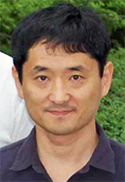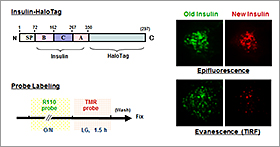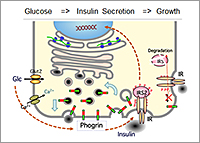
Reserch
Institute for Molecular and Cellular Regulation
Laboratory of Secretion Biology

Seiji Torii Associate Professor
Our research aim is to elucidate formation mechanisms for highly integrated functions of differentiated cells such as pancreatic ß-cells and neuronal cells.
With the decrease of neuroendocrine function, a variety of diseases increase, which include metabolic syndrome and neuronal disorders. To understand fundamental mechanisms on such human diseases, we investigate the biosynthesis and secretion of peptide hormones, and the regulation of cell survival and death, with use of molecular and cellular technical approaches. In a collaborative study with some engineering researchers, we are also developing fluorescent or luminescent probes for analyzing cancer, diabetes, and ischemia.
Research and Education
1) Mechanisms on peptide hormones secretion and secretory granule formation in endocrine cells.

Insulin secretion analysis with multi-tag imaging
system.
Peptide hormones synthesized at the endoplasmic reticulum are transported to the trans-Golgi network (TGN) where they are sorted and specifically targeted to secretory granules in neuroendocrine cells. We found that secretory granule protein, phogrin, binds to CPE and clathrin adaptors through the luminal region and the cytoplasmic tail, respectively, suggesting that this transmembrane protein has a role in hormone sorting by providing a communication device between the granule lumen and the cytosol. We further investigate the regulatory secretion and degradation of peptide hormones using a recently developed multi-tag imaging system.
2) Mechanisms on growth, survival, and cell death in pancreatic ß-cells and neuronal cells.

Insulin secretion and autocrine
signals in pancreatic beta-cells.
We have discovered that phogrin functions as a regulatory mediator bridging between glucose/insulin secretion and autocrine insulin signaling in the growth of pancreatic ß-cells. We are analyzing its physiological role with use of the gene-targeted mouse. In addition, we investigate the signaling pathway of novel necrotic cell death such as necroptosis and ferroptosis with tumor cells or neuronal cells.
3) Development of fluorescent or luminescent probes for investigating various diseases.
In a collaborative study with some engineering groups, we are developing fluorescent or luminescent probes to dissect molecular mechanisms of dysfunction in cancer, diabetes, and other diseases. We demonstrated previously that reactive oxygen species are localized at autophagosomes/lysosomes in a basal state and they are eventually implicated to neuronal cell death by cerebral ischemia.
Recent Publications
- Sun M, Watanabe T, Bochimoto H, Sakai Y, Torii S, Takeuchi T, Hosaka M. Multiple sorting systems for secretory granules ensure the regulated secretion of peptide hormones. Traffic 14, 205-218, 2013.
- Gomi H, Kubota-Murata C, Yasui T, Tsukise A, Torii S. Immunohistochemical analysis of IA-2 family of protein tyrosine phosphatases in rat gastrointestinal endocrine cells. J Histochem Cytochem 61, 156-168, 2013.
- Hou N, Mogami H, Kubota-Murata C, Sun M, Takeuchi T, Torii S. Preferential release of newly synthesized insulin assessed by a multi-label reporter system using pancreatic β-cell line MIN6. PLoS One 7, e47921, 2012.
- Yamaguchi R, Hosaka M, Torii S, Hou N, Saito N, Yoshimoto Y, Imai H, Takeuchi T. Cyclophilin C-associated protein regulation of phagocytic functions via NFAT activation in macrophages. Brain Res 1397, 55-65, 2011.
- Saito N, Takeuchi T, Kawano A, Hosaka M, Hou N, Torii S. Luminal interaction of phogrin with carboxypeptidase E for effective targeting to secretory granules. Traffic 12, 499-506, 2011.
- Kubota C, Torii S, Hou N, Saito N, Yoshimoto Y, Imai H, Takeuchi T. Constitutive reactive oxygen species generation from autophagosome/lysosome in neuronal oxidative toxicity. J. Biol. Chem. 285, 667-674, 2010.
- Torii S, Saito N, Kawano A, Hou N, Ueki K, Kulkarni RN, Takeuchi T. Gene silencing of phogrin unveils its essential role in glucose-responsive pancreatic beta-cell growth. Diabetes 58, 682-692, 2009.
- Torii S. Expression and function of IA-2 family proteins, unique neuroendocrine-specific protein-tyrosine phosphatases. Endocrine J. 56, 639-648, 2009.
Laboratory of Secretion Biology
Associate Professor: Seiji Torii
TEL: +81-27-220-8859
FAX: +81-27-220-8896
e-mail: storii@gunma-u.ac.jp
URL: http://www.imcr.gunma-u.ac.jp/lab/secbio/ ![]()
